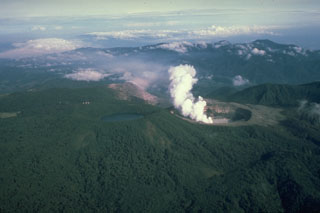Report on Poas (Costa Rica) — March 1995
Bulletin of the Global Volcanism Network, vol. 20, no. 3 (March 1995)
Managing Editor: Richard Wunderman.
Poas (Costa Rica) Continued moderate seismicity, but no tremor; lake rise
Please cite this report as:
Global Volcanism Program, 1995. Report on Poas (Costa Rica) (Wunderman, R., ed.). Bulletin of the Global Volcanism Network, 20:3. Smithsonian Institution. https://doi.org/10.5479/si.GVP.BGVN199503-345040
Poas
Costa Rica
10.2°N, 84.233°W; summit elev. 2697 m
All times are local (unless otherwise noted)
During February the green-turquoise colored lake rose to its December 1994 level. The lake contained clouds of suspended sulfur, and had a temperature of 47°C. Lake evaporation caused minor steam clouds (columns <50 m tall); in the S part of the lake constant bubbling took place with sporadic gushing of water.
During February seismic station POA2 (located 2.7 km SW of the principal crater) registered 4,937 earthquakes (high, medium, and low-frequency events combined). This was the largest number of earthquakes since July 1994. It followed a low of 2,555 earthquakes in December 1994 and previous highs of ~7,000 earthquakes in March and April 1994. Although up to 200-300 hours of tremor took place during mid-1994, in February 1995 less than an hour of tremor was registered. Events of high frequency (above 3 Hz) took place 20 times, a comparatively high number for Poás.
Geological Summary. The broad vegetated edifice of Poás, one of the most active volcanoes of Costa Rica, contains three craters along a N-S line. The frequently visited multi-hued summit crater lakes of the basaltic-to-dacitic volcano are easily accessible by vehicle from the nearby capital city of San José. A N-S-trending fissure cutting the complex stratovolcano extends to the lower N flank, where it has produced the Congo stratovolcano and several lake-filled maars. The southernmost of the two summit crater lakes, Botos, last erupted about 7,500 years ago. The more prominent geothermally heated northern lake, Laguna Caliente, is one of the world's most acidic natural lakes, with a pH of near zero. It has been the site of frequent phreatic and phreatomagmatic eruptions since an eruption was reported in 1828. Eruptions often include geyser-like ejections of crater-lake water.
Information Contacts: E. Fernández, V. Barboza, and J. Barquero, OVSICORI; G. Soto, ICE.

